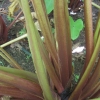Use As Food
Makes good poi of distinctly yellow color. The taro has excellent quality as a table taro. The Mana and the Lauloa taros are used in preference to all others for making the Hawaiian pudding kūlolo, a combination of grated taro and coconut milk.
Distribution
Limited; grown primarily under upland, dryland culture (māla).
General Characteristics
Medium in height, erect, moderately stocky, maturing within 9 to 12 months; the most striking character is prolific branching, as many as ten branches often being produced.
Ha (Petiole)
70 to 95 cm. long, olive-green tinged with reddish-brown and pink; the pinkish color is distinct near the kōhina (base), lilac-purple at apex, with a broad, light pink to whitish edge along the stem, white at kōhina (base) with lilac pink for 1 to 2 cm. above.
Lau or Lu'au(Leaf Blade)
35 to 45 cm. long, 20 to 30 cm. wide, 25 to 35 cm, from tip to base of sinus (māwae), vertical, firm-chartaceous (this means paper like), arrow head shaped, dark green; piko yellowish; round leaf section (lobes) acute with white lihi māwae (sinus).
'I'o kalo (Corm)
Flesh yellow with light yellowish fibers; skin cream colored, dark purple along leaf-scar rings.
Pua (Flower)
Produced rather profusely; Hā (peduncle) light green flecked with reddish-brown; flower cover (spathe) small, delicate, narrow, 12 to 16 cm. long, the lower tubular portion 2 to 2.5 cm. long, light green, the upper portion tightly rolled, light yellow; spadix (spike of flower) rather delicate, 6 to 9 cm. long, the sterile appendage (tip of flower's spike) 4 to 8 mm. long.
Remarks
Because of excessive branching, the shape of the ‘i‘o kalo (Corm) is very irregular. This South Sea introduction variety is desirable for poi. The ‘i‘o kalo (Corm) are similar to those of the Kai group, being tough and rubbery when cooked.







